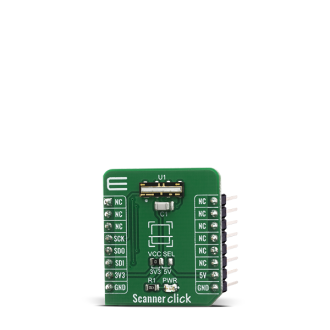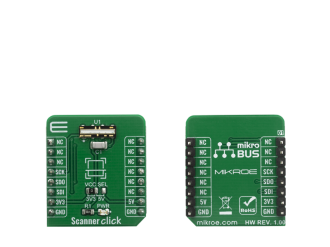
We strongly encourage users to use Package manager for sharing their code on Libstock website, because it boosts your efficiency and leaves the end user with no room for error. [more info]

Rating:
Author: MIKROE
Last Updated: 2020-05-21
Package Version: 1.0.0.0
mikroSDK Library: 1.0.0.0
Category: Optical
Downloaded: 3345 times
Not followed.
License: MIT license
Scanner Click features a high-sensitivity 300-dpi, linear optical sensor array with integrated 8-bit analog-to-digital converters labeled as the TSL3301CL. This Click board™ has the array that consists of 102 pixels, each measuring 85 μm (H) by 77 μm (W) and spaced on 85 μm centers.
Do you want to subscribe in order to receive notifications regarding "Scanner click" changes.
Do you want to unsubscribe in order to stop receiving notifications regarding "Scanner click" changes.
Do you want to report abuse regarding "Scanner click".


Library Description
This library holds functions that allow user to start up the device, write to the device, make one clock pulse and control each individual pin used.
Key functions:
void scanner_startup (); - Function is used to start up the linear array sensor.void scanner_serial_cmd ( uint8_t cmd ); - Function is used to write command to the device.void scanner_clock ( ); - Function is used to make SCK pulse.void scanner_read_pixel ( uint8_t *pixel_data ); - Function is used to read pixel status.Examples description
The application is composed of three sections :
void application_task ( )
{
scanner_pixel_log( log_write );
}
Other mikroE Libraries used in the example:
Additional notes and informations
Depending on the development board you are using, you may need USB UART click, USB UART 2 click or RS232 click to connect to your PC, for development systems with no UART to USB interface available on the board. The terminal available in all MikroElektronika compilers, or any other terminal application of your choice, can be used to read the message.